CMake is a cross-platform free and open-source software tool designed to build, test, and package the software. CMake uses a simple platform and compiler-independent configuration files to control the software compilation process. It leads to the production of native makefiles and workspaces, which are, in turn, used in a compiler environment of choice.
In this post, we are going to show you how to install CMake on your Ubuntu system. Our Ubuntu release of choice in this tutorial is Ubuntu 18.04 LTS.
Installing CMake on Ubuntu
Prerequisites
Before installing CMake, ensure you have root privileges and that your system is up to date by running the commands below.
sudo apt update sudo apt upgrade
Method 1: Install CMake using Ubuntu Software
If you don’t want to go about executing a bunch of commands on the Linux Terminal, then this method is for you. As of writing this post, the available stable version of CMake is 3.17.3.
Step 1. Launch the “Ubuntu Software Install” from the Ubuntu applications menu, as shown in the image below.

Launch Software Install from Ubuntu Applications
Step 2. On the Ubuntu Software “Search Bar” at the top, type the word CMake and press “Enter.” You will see a list of applications but only Click on the CMake icon. It will probably be the first item on the list, as shown in the image below.
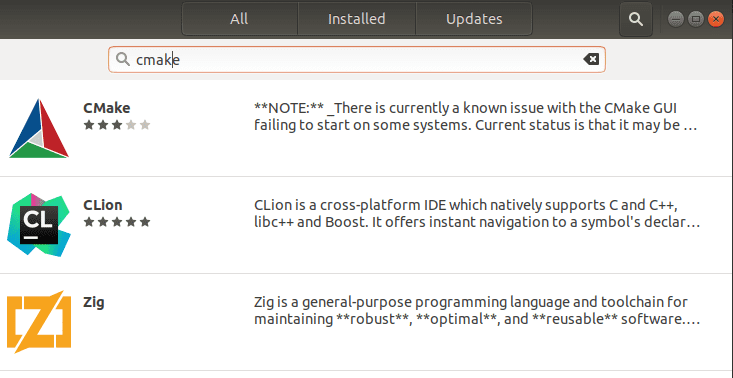
Search for CMake in the Search Bar
Step 3. Click on the “Install” button to download and install CMake on your Ubuntu system. You might be required to enter your root password to continue with the installation.

Click on the Install button to install CMake in your system.
Step 4. You can track the installation progress using the percentage below, as shown in the image.
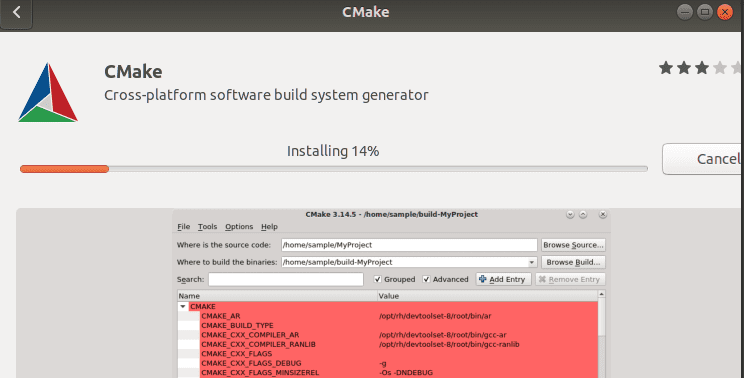
See the Installation progress on the Percentage bar.
CMake will now install in your system. If the process completes successfully, You should see a window similar to the one on the image below.
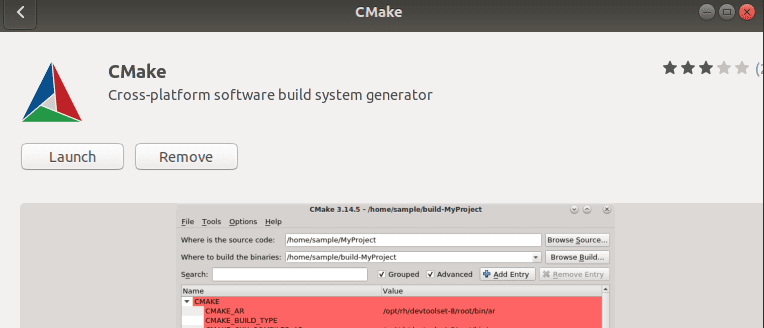
Launch CMake after a successful installation
Step 5. To start CMake, click on the “Launch” button. The CMake window should open, as shown in the image below.
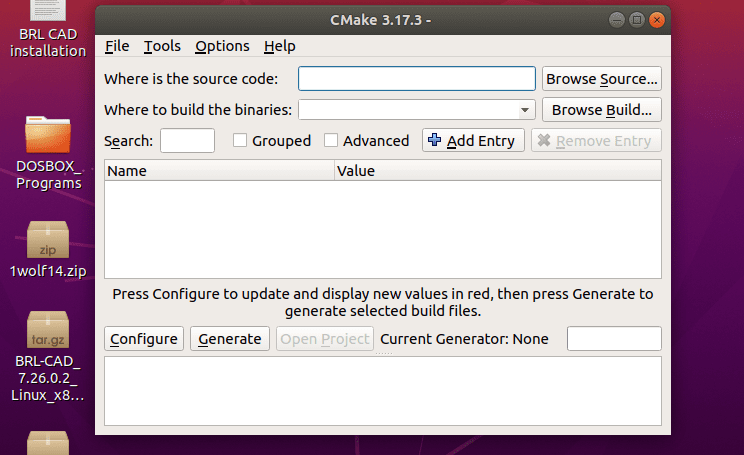
Launch CMake
Uninstall CMake using the Ubuntu Software
If you wish to remove CMake from your system using the Graphical User Interface GUI), it is pretty straightforward.
Step 1. Launch the Ubuntu Software application and search for “CMake” on the search bar above.
Step 2. Click on the CMake application that appears on the list. You should see a window similar to the one below.

Remove/Uninstall CMake.
Step 3. Click on the “Remove” button to uninstall CMake from your Ubuntu system.
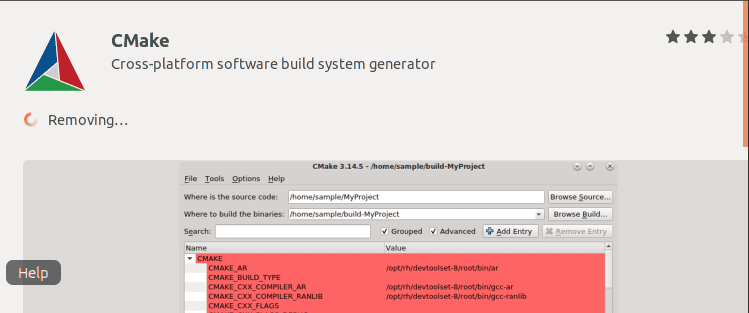
Removing CMake on Ubuntu
From the image below, we can see “CMake” is uninstalling from your system.
Method 2: Installing CMake using command-line
This is the method to follow to install CMake in your Ubuntu system to those who prefer the Command-line method over the Graphical User Interface. There are two ways which you can use to install CMake on your system via the Terminal:
a) Using snap
b) Using the source code from the official CMake website
Snap app
Step 1. Launch the Ubuntu Terminal and execute the command below.
sudo snap install cmake –classic
Once the installation completes, run the “–version” command below to see the CMake version installed in your system.
cmake --version

Install CMake via snap
To Remove/Uninstall CMake using snap in the command-line, run the command below.
sudo snap remove cmake
Note, this method only works for CMake installed via Snap or Graphical way using the Ubuntu Software.

Remove CMake using Snap
Installing CMake using Source Code VI
Before writing this post, I tried installing CMake from the Ubuntu repository and PPA, but none of them installed the latest CMake version. To install the latest CMake version, follow the steps below.
Step 1. Download the CMake source code from its official website. That can be done using the “wget” command on the Terminal, as shown below. Make sure to replace the link in the below command with the link you copy from the official website.
$ wget https://github.com/Kitware/CMake/releases/download/v3.17.3/cmake-3.17.3.tar.gz

Download Source code using wget
Step 2. Navigate to the directory where you downloaded the code. It should be the folder in which you run the “wget” command. Run the “tar” command to extract the contents.
tar -zxvf cmake-3.17.3.tar.gz

Extract the source code using tar command
Step 3. Navigate to the newly created CMake directory using the “cd” command.
cd cmake-3.17.3

Navigate to CMake directory
Step 4. Run the command below to compile and install CMake in your Ubuntu system.
sudo ./bootsrap
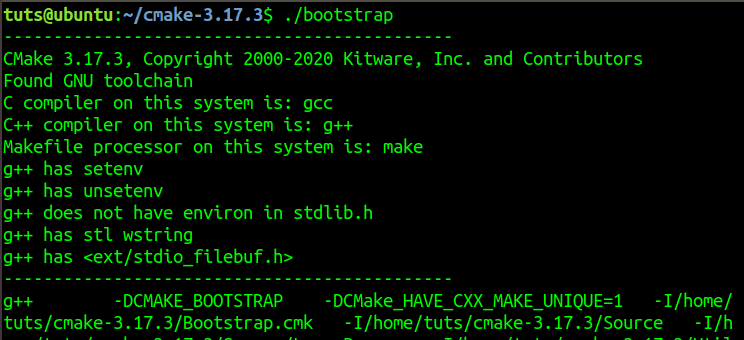
Configure and Install CMake
Once the process completes, you should see a message, as in the image below.

CMake bootstrapped successfully
Step 5. Run the “make” command.
make

Run the make command
Step 6. Run the “make install” command to install CMake in your system.
make install

Make Install command
Step 7. To confirm that CMake installed successfully in your system, run the “version” command.
cmake --version

CMake version
To Remove/Uninstall CMake installed using the “make” command, run the command below.
sudo make uninstall

Make Uninstall command
Conclusion
Those are two ways to install CMake on your Ubuntu system. If you are new to using CMake and would like to know more about it, head over to the official site to read their comprehensive documentation.


10 comments
There are a couple typos e.g. `sudo snap install cmake -classic` should be `–classic`, or `sudo ./bootsrap` should be `bootstrap` etc.
I am normally a language learner, but thrilled of what a detailed guide you made here today. You could learn alot from this. Very Polished detail.
thanks for your instruction.
On “ubuntu 20.04” I couldnt install cmake in terminal “sudo snap install cmake -classic” I had to change it to “–classic” because I got ” error: unknown flag `c’ “
same, also get error: ./bootstrap: No such file or directory
Thanks for the feedback. The typo is corrected.
thank you so much for this guide, really appreciate it
In the commands, you said sudo ./bootsrap instead of sudo ./bootstrap.
it is “sudo snap install cmake –classic”
There are a few issues with these instructions. In some cases in my Ubuntu 20 Virtual Machine you need to add – twice, as in sudo snap install cmake –-classic. Moreover, Step 4 of Method 2 has an obvious typo, sudo ./bootsrap should read bootstrap, with a second t, which may be confusing to users less experienced or with English as a second language. But in any case, it was helpful, thank you.
The command for installing CMake has a typo. Its should have “–classic” instead of “-classic” e.g. two of the dashes. The full line is thus:
sudo snap install cmake –classic